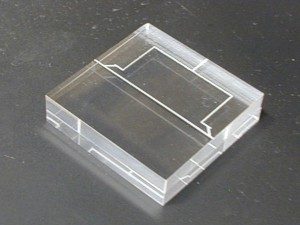
A sapphire capillary
A strong wakefield is excited only if the laser light is sufficiently intense to exert a large ponderomotive force on the plasma. This can be realised by focusing the laser pulse to a small spot. However, diffraction of the laser beam limits the acceleration length. This limitation can be overcome through the use of a plasma channel that has a radial plasma density profile with a minimum on axis, which acts as a waveguide because the refractive index of the plasma is lower in regions of higher density. The plasma waveguide is produced using an electrical discharge in a hydrogen-filled capillary tube, a technique that has been pioneered and successfully implemented at the University of Oxford.
Structured capillaries (manufactured by fs laser micromachining) are being developed for studies of (a) wall guiding of laser pulses at lower plasma density and (b) two-stage bunching schemes where the first capillary is employed for compression of the electron bunch while the second capillary is the main accelerating medium.
